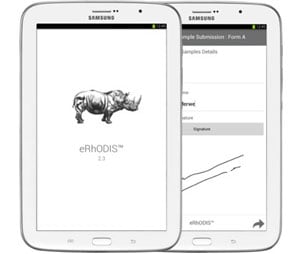
Top stories






More news












RhODIS was developed as a forensic tool to assist in addressing the current rhino poaching crisis in South Africa by linking recovered rhinoceros horn to poaching cases which has supported in the successful prosecution of poachers and wildlife crime syndicates.
The mobile application, which provides the information technology backbone to support RhODIS, was unveiled at the recent international DNA training workshop held at the South African Wildlife College in collaboration with the Department of Environmental Affairs and the International Consortium on Combating Wildlife Crime (ICCWC).
South Africa is currently facing a crisis as the number of rhinos killed has increased drastically. This can be seen in the large leap from 333 rhinos poached in 2010 to 860 this year. The report further showed that the Kruger National Park continues to bear the brunt of rhino poaching, as reported by the DEA this month. The continued fight against rhino poaching has united the nation - with valiant and well-coordinated efforts implemented by government, law enforcement agencies, South African National Parks and private organisations.
Craige Fleischer, director of mobile communications at Samsung Electronics South Africa explains, "The availability of eRhODIS will enhance data accuracy, increase access of information to authorities and have a positive impact in convicting criminals of these crimes. Samsung is honoured to be in a position to contribute innovative technology solutions aimed at supporting this great cause and assist in protecting South Africa's wildlife, and more specifically the rhino."
The eRhODIS mobile app is used to gather DNA evidence, geographical data and upload photographs. Collected information has already been used as evidence to support several cases involving poachers and traffickers. It links the suspect to a specific crime scene through matching DNA from recovered horns and weapons used to kill animals.
The database also includes DNA profiles of live rhinoceros and horn in stockpiles, which further provides a powerful tool for authorities to trace and link each animal and horn individually. The archive presently includes over 10,000 samples from black and white rhinoceros from all over Africa.
The eRhODIS app has been designed to guide the user through the standard procedure of collecting samples and completing required data fields. It is intended to support the use of the rhinoceros sampling kits developed as part of the project and is available to all investigators, the environmental management inspectorate, veterinarians and officials trained and authorised to use the RhODIS kits.
During a rhino poaching investigation, data is initially collected at the crime scene. Equipped with a Samsung GALAXY Note 8 loaded with the application, investigators are able to collect data related to the DNA evidence and upload information to a secure cloud server as soon as the device is within network range. The laboratory receives this information instantly and is able to view who submitted the report. A completed sample collection form, in PDF format, is emailed to the investigator which is then printed and added as a paper copy to the evidence bag with samples for submission to the laboratory.
Dr Cindy Harper, director of the Veterinary Genetics Laboratory at the University of Pretoria, said, "RhODIS continues to play a vital role in fighting rhinoceros crime in South Africa and its implementation and utilisation internationally could play a key role in bringing people and syndicates involved in wildlife crime to book."
"There is an urgent need to curb rhino poaching in South Africa and we are proud to be associated with this project that assists with the prevention and combat of environmental crime. Conservation success depends on innovative private and public sector partnerships which offer accelerated access and exchange of information to link groups involved in environmental offences to specific offenses," concludes Fleischer.